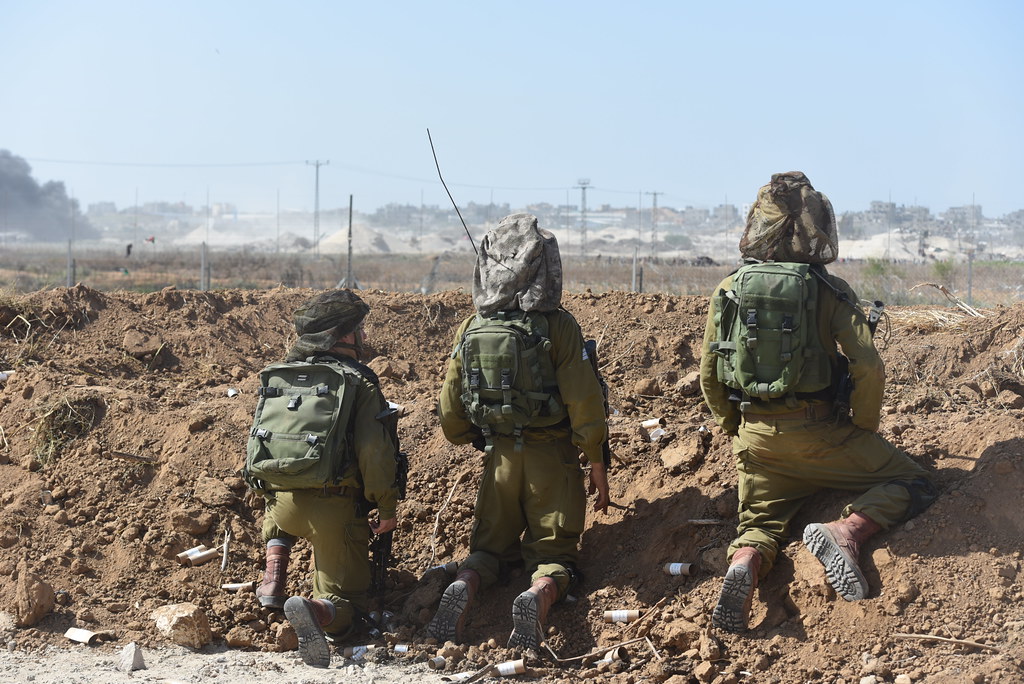
IDF soldiers stationed in Southern Israel trained along the Gaza border to ensure an ongoing level of preparedness.> Yoav Karen, CC BY-NC 2.0 DEED via Wikimedia Commons.
Latest developments
- Nearly three weeks after a savage Hamas terror attack left at least 1,400 people murdered, more than 5,000 wounded, and at least 220 abducted, Israel’s war against Hamas in the Gaza Strip is continuing with intensive bombing of Hamas targets from the air, and forces ready for a major ground operation. There have been continuing small scale IDF ground incursions. Hamas and other armed groups continue to fire rockets at Israeli towns and cities, mostly in the south of Israel, though at a lower rate in recent days. They also continue to attempt to infiltrate Israel via the sea.
- Exchanges of fire across the Israeli-Lebanese border are increasing, with Hezbollah and Palestinian groups launching anti-tank missile and rocket attacks, and Israel targeting the squads responsible, including five on Wednesday. Israeli officials are sending a consistent message that their priority is defeating Hamas, but are warning of a devastating Israeli response if Hezbollah escalates. Israel has evacuated tens of thousands of civilians from towns and villages close to the Lebanese and Gazan borders. Leaders of Hamas and Palestinian Islamic Jihad held talks with Hezbollah leader Hassan Nasrallah in Lebanon on Wednesday.
- A second US carrier strike group is on route to the region, to join the Gerald R. Ford Strike Group already providing deterrence against Hezbollah in the Eastern Mediterranean. On Thursday 19 October, a US warship in the Red Sea intercepted missiles and drones fired by Iranian-backed Houthi fighters in Yemen, apparently towards Israel. US bases in Syria and Iraq also come under drone attack last week.
- Qatar is claiming progress in its efforts to mediate the release of reportedly 50 more hostages with dual nationality. This follows the release on Monday of two elderly Israeli women, whose husbands remain in captivity. Two American-Israelis were also released last Friday, a mother and 18-year old daughter. The remaining hostages include tens of children including babies and toddlers. Seven British nationals still missing may be among the hostages.
- International demands for more aid to enter the Gaza Strip are increasing, after 34 trucks entered from Egypt in two consignments over the weekend, a further 20 trucks on Monday, and eight on Tuesday. At a UN Security Council meeting on Tuesday, US seccretary of state Anthony Blinken reiterated Israel’s right to self defence, whilst stating that “humanitarian assistance must be able to flow into Gaza” and that “humanitarian pauses must be considered for these purposes”. UN agencies say that there is dire and urgent need for much larger quantities of aid, including water, medical supplies, fuel and food. The RAF has airlifted a first consignment of aid from the UK to Gaza via Egypt.
- The IDF released images on Tuesday appearing to show half a million litres of fuel held in Gaza that Hamas was refusing to give to civilians. Israel continues to instruct Gazan civilians to move south from Gaza city for their own safety. There are reports Hamas has worked to prevent this, though UN agencies cite 1.4 million people internally displaced. As of Tuesday the Hamas-run health ministry in Gaza claimed there are 5,791 fatalities in the Gaza Strip, though the number cannot be independently verified, nor the proportion of Palestinian casualties that are civilians.
- On Monday, the UK government announced its assessment that, in line with Israel’s position and other independent assessments, a misfiring Palestinian rocket most likely caused the 17 October blast at the Al-Ahli hospital.
- President Macron visited Israel on Tuesday, following similar visits by other western leaders. He suggested the international coalition against Daesh also fight against Hamas, and called for a “decisive relaunch” of a diplomatic process towards Palestinian statehood.
- In a video posted on 21 October, Israeli opposition leader Yair Lapid proposed strategic aims for the war should include Hamas being replaced in Gaza by “by a different Palestinian leadership with support from the Arab world”.
- Trafalgar Square was the venue last Sunday for a rally of tens of thousands organised by British Jewish community groups demanding the release of hostages. The crowd listened to harrowing accounts from family members of those abducted into the Gaza Strip. An estimated crowd of 100,000 pro-Palestinian protestors marched in central London on Saturday, with reports of some extremist chanting, and 10 arrested on various offences.
The coming days
- Uncertainty surrounds the timing and scale and of an Israeli ground offensive, and there are signs of a continuing debate among Israeli decision makers on how best to proceed. Expectations for a ground operation are fuelled by the very large numbers of reservists (approximately 360,000) called away from their civilian lives, the domestic pressure to act, and the assertion of military commanders that they are ready. However, uncertainty is sown by the lack of clarity over the feasibility, duration, and costs of a full-scale ground operation; concern to give time for mediating the release of hostages; international pressure to facilitate humanitarian aid; and the possibility that Israel is continuing to secure significant achievements from the air.
- International diplomatic attention is likely to remain focussed on the need to get humanitarian aid in, and efforts to secure the release of more hostages.
- Meanwhile international concern is growing that the conflict may spread, either because of an Iranian decision, or as a result of unintended escalation due to miscalculation, particularly between Israel and Hezbollah.
In Parliament
- In a statement to Parliament on Monday, following his visit to the region, prime minister Rishi Sunak announced a doubling of additional emergency humanitarian aid to civilians in Gaza to £20m. He referred to the deployment of RAF and Royal Navy assets to prevent escalation. He declared that Hamas cannot be allowed to control Gaza or any part of the Palestinian territories, and affirmed the importance of a two-state solution.
- In response, Labour leader Keir Starmer said it was important, “to defeat Hamas so that nobody need suffer like this again and so that we might once more see a road to a lasting peace, with a Palestinian state alongside a safe and secure Israel”. He called also for “clear humanitarian corridors within Gaza for those escaping violence” and said that “basic services, including water, electricity and the fuel needed for it, cannot be denied.”
- David Lammy and Lisa Nandy, in a letter to the foreign and defence secretaries on Tuesday, called for a further £10m in aid; appointing a UK special coordinator for aid to Gaza; deploying a UK team of experts to the region to support emergency relief; providing support for the UN; and insisting on entry of fuel.
The escalation threat of Iran and Hezbollah
- Iran arms and funds proxies and allies across the region, including Hamas and Palestinian Islamic Jihad in the Gaza Strip, Hezbollah in southern Lebanon, and Houthi rebels in Yemen, as well as groups in Syria and Iraq.
- Hezbollah – a Shiite Lebanese group that is the most potent in Lebanese politics – poses by far the greatest threat to Israel, and potentially a far greater threat than Hamas. As a Shiite Islamist group, Hezbollah owes direct allegiance to the regime in Tehran.
- Since the 2006 Second Lebanon War between Israel and Hezbollah, the group acquired a massive arsenal of rockets, estimated several years ago at 130,000. Some of them are capable of reaching deep into Israel with heavy payloads, and some are precision-guided. With precision guided weapons Hezbollah could target key infrastructure including power stations, air bases, the Haifa oil refinery, Ben Gurion International Airport, and the Dimona nuclear reactor. It could also attempt a murderous ground offensive comparable to that carried out by Hamas. Hezbollah is known to embed its rocket infrastructure in civilian areas in southern Lebanon and in Beirut. The extent of the Hezbollah threat would mean that in the case of an escalation, Israel would deploy massive air power against Hezbollah’s rocket firing capability, and potentially a significant ground operation also.


